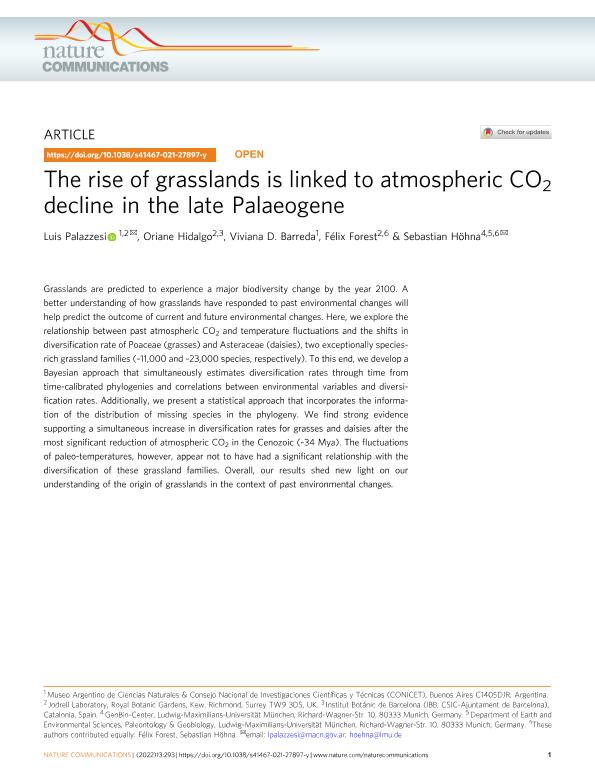Mostrar el registro sencillo del ítem
dc.contributor.author
Palazzesi, Luis

dc.contributor.author
Hidalgo, Oriane
dc.contributor.author
Barreda, Viviana Dora

dc.contributor.author
Forest, Félix
dc.contributor.author
Höhna, Sebastian
dc.date.available
2023-10-09T12:14:27Z
dc.date.issued
2022-01
dc.identifier.citation
Palazzesi, Luis; Hidalgo, Oriane; Barreda, Viviana Dora; Forest, Félix; Höhna, Sebastian; The rise of grasslands is linked to atmospheric CO2 decline in the late Palaeogene; Nature; Nature Communications; 13; 1; 1-2022; 1-10
dc.identifier.issn
2041-1723
dc.identifier.uri
http://hdl.handle.net/11336/214471
dc.description.abstract
Grasslands are predicted to experience a major biodiversity change by the year 2100. A better understanding of how grasslands have responded to past environmental changes will help predict the outcome of current and future environmental changes. Here, we explore the relationship between past atmospheric CO2 and temperature fluctuations and the shifts in diversification rate of Poaceae (grasses) and Asteraceae (daisies), two exceptionally species-rich grassland families (~11,000 and ~23,000 species, respectively). To this end, we develop a Bayesian approach that simultaneously estimates diversification rates through time from time-calibrated phylogenies and correlations between environmental variables and diversification rates. Additionally, we present a statistical approach that incorporates the information of the distribution of missing species in the phylogeny. We find strong evidence supporting a simultaneous increase in diversification rates for grasses and daisies after the most significant reduction of atmospheric CO2 in the Cenozoic (~34 Mya). The fluctuations of paleo-temperatures, however, appear not to have had a significant relationship with the diversification of these grassland families. Overall, our results shed new light on our understanding of the origin of grasslands in the context of past environmental changes.
dc.format
application/pdf
dc.language.iso
eng
dc.publisher
Nature

dc.rights
info:eu-repo/semantics/openAccess
dc.rights.uri
https://creativecommons.org/licenses/by/2.5/ar/
dc.subject
Paleogene
dc.subject
atmospheric CO2
dc.subject
grasslands
dc.subject
Patagonia
dc.subject.classification
Paleontología

dc.subject.classification
Ciencias de la Tierra y relacionadas con el Medio Ambiente

dc.subject.classification
CIENCIAS NATURALES Y EXACTAS

dc.title
The rise of grasslands is linked to atmospheric CO2 decline in the late Palaeogene
dc.type
info:eu-repo/semantics/article
dc.type
info:ar-repo/semantics/artículo
dc.type
info:eu-repo/semantics/publishedVersion
dc.date.updated
2023-10-09T10:37:28Z
dc.journal.volume
13
dc.journal.number
1
dc.journal.pagination
1-10
dc.journal.pais
Reino Unido

dc.journal.ciudad
Londres
dc.description.fil
Fil: Palazzesi, Luis. Consejo Nacional de Investigaciones Científicas y Técnicas. Oficina de Coordinación Administrativa Parque Centenario. Museo Argentino de Ciencias Naturales "Bernardino Rivadavia"; Argentina
dc.description.fil
Fil: Hidalgo, Oriane. Royal Botanic Gardens; Reino Unido
dc.description.fil
Fil: Barreda, Viviana Dora. Consejo Nacional de Investigaciones Científicas y Técnicas. Oficina de Coordinación Administrativa Parque Centenario. Museo Argentino de Ciencias Naturales "Bernardino Rivadavia"; Argentina
dc.description.fil
Fil: Forest, Félix. Royal Botanic Gardens; Reino Unido
dc.description.fil
Fil: Höhna, Sebastian. Ludwig Maximilians Universitat; Alemania
dc.journal.title
Nature Communications

dc.relation.alternativeid
info:eu-repo/semantics/altIdentifier/url/https://www.nature.com/articles/s41467-021-27897-y
dc.relation.alternativeid
info:eu-repo/semantics/altIdentifier/doi/http://dx.doi.org/10.1038/s41467-021-27897-y
Archivos asociados
